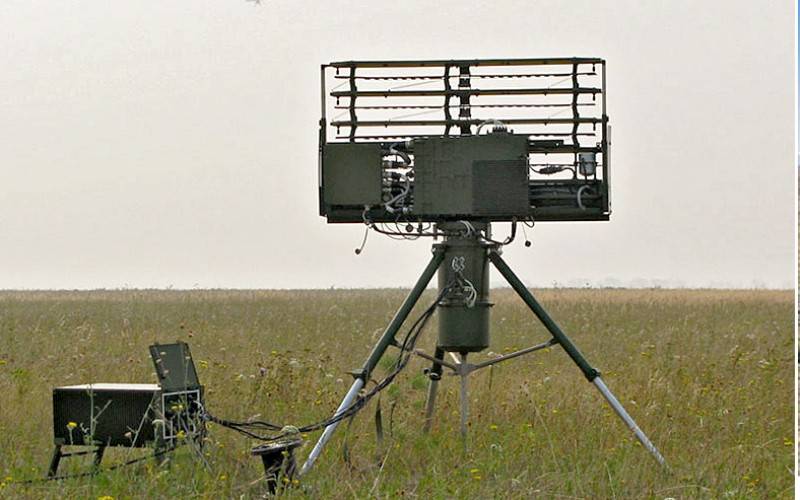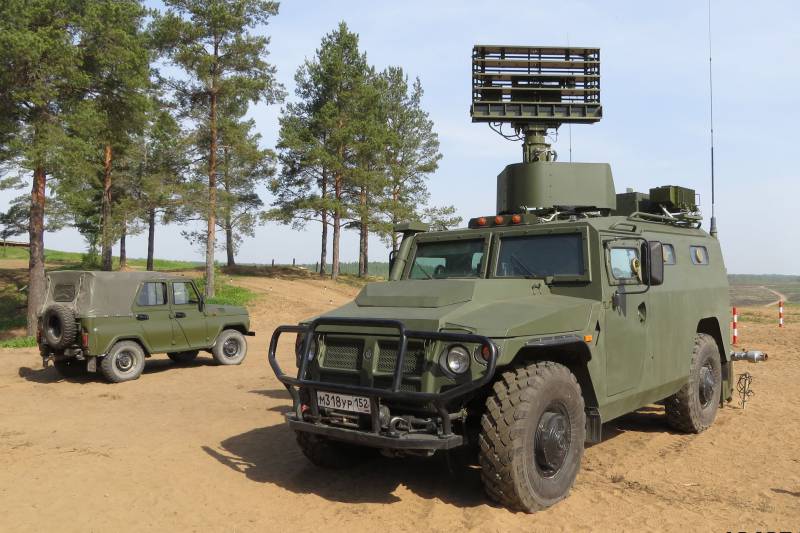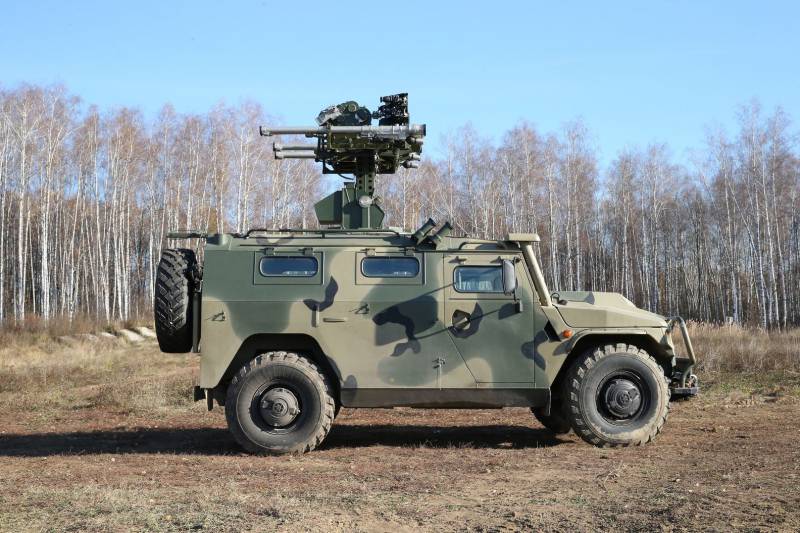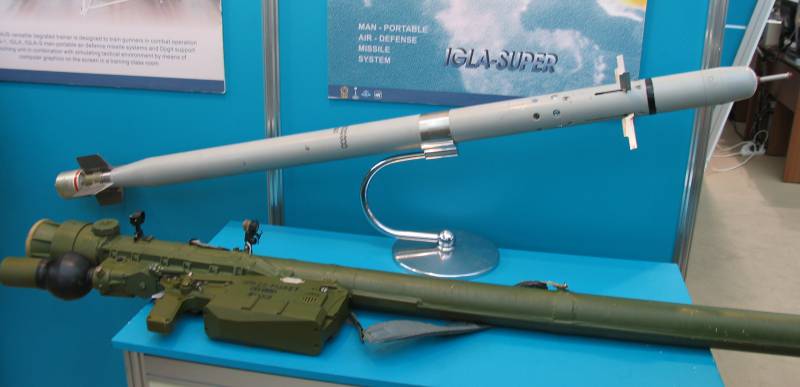Anti-aircraft missile system "Gibka-S"
The aim of the project “Gibka-S” was to create a promising system incorporating self-propelled vehicles with special equipment. Due to the existing equipment of the machine complex have the ability to monitor the air situation and to detect targets, as well as to attack the found objects using missiles man-portable air defense systems. It is expected that such use of existing MANPADS in the same system with the new equipment will significantly improve the effectiveness of combat work in comparison with existing anti-aircraft weapons.
The development of the project "Gibka-S" was carried out by several organizations led by the Kolomna Engineering Design Bureau. The development and manufacture of individual components of the system was also assigned to NPP Rubin (Penza), the All-Russian Scientific Research Institute Signal (Kovrov), the Institute of Applied Acoustics (Dubna), the Saratov Aggregate Plant, the Ryazan Instrument Plant and the Federal State Unitary Enterprise GosNIIAS " (Moscow). Together, several companies have shaped the whole system, and then implemented it in the form of prototypes.
As can be seen from the name of the new project, it is based on some ideas that have already been used to create promising systems. Since the middle of the last decade, the domestic defense industry has been producing the Gibka anti-aircraft systems designed for boats and small displacement ships. The complex of this type is a launcher with mounts for the installation of missiles of existing MANPADS. In addition, "Bending" is equipped with optical-electronic equipment to search for targets and pre-targeting missiles. In the new project, similar ideas were adapted for use by land forces.
The system "Gibka-S" consists of two main components that ensure the growth of combat capabilities of existing MANPADS. This is a combat vehicle of the anti-aircraft gunners unit (BMO), as well as a reconnaissance and command vehicle of the anti-aircraft platoon commander (MRUK). Both vehicles of the complex are proposed to be built on the basis of existing protected vehicles with the required mobility characteristics. So, the already existing prototype of the Gibka-S system is based on domestic-made Tiger armored cars. Due to this, the calculation of the anti-aircraft complex gets the opportunity to move along the highway or over rough terrain, accompany convoy, etc.
The tasks of tracking the air situation, finding targets and issuing target designation are assigned to the reconnaissance and command vehicle of the platoon commander. MRUK is proposed to be built on the basis of the existing automobile chassis, such as the armored vehicle "Tiger". During the modernization of the new project, the base machine receives a set of various equipment necessary for solving basic tasks. Part of the units is mounted on the roof of the hull, and some devices are placed inside the cab. Thanks to such an upgrade, the machine is able to perform all the tasks assigned, thus increasing the efficiency of the anti-aircraft gunners.
Some devices designed to solve new problems are installed on the roof of the base machine. First of all, it is a turntable with an antenna of the Harmony 1L122 radar. The antenna is located in front of the roof and is able to maintain a circular view of the airspace. Behind the turntable there are other elements of instrumentation, including communication systems, etc.

Radar 1Л122 "Harmony" in a figurative version. Photo Arms-expo.ru
Radar 1Л122 is designed to detect air targets of various types, their automatic tracking and the issuance of information on the routes to various consumers. A characteristic feature of the station, which positively influences the parameters of its work, is the use of a phased antenna array of 1200x800 mm size. A horizontal overview is provided by the antenna's turning mechanisms, a vertical one by electronic scanning. Depending on the modification, Garmonium Station is capable of updating target data with a tempo from 2 to 10 s, which is caused by the speed of the turn of the antenna array.
By receiving a constant voltage of 22-30 V and consuming up to 800 W, the station provides a search for targets at distances up to 40 km and altitudes of at least 10 km. Provides a circular view of the azimuth and tracking of the sector within the elevation angles from -5 ° to + 45 °. The maximum speed of the air target is 700 m / s. The coordinates of the target are determined with an accuracy of 100 m in range, to 30 'in azimuth and to 1 ° 30' in elevation. It is possible to work in the conditions of the use of passive and active interference by an adversary of a certain power.
In the original configuration, which implies the use of a mobile system with the possibility of carrying, the 1L122 radar is equipped with a control and monitoring system in the form of a protected laptop computer and communications equipment. In the case of the MIBC of the “Gibka-S” system, such equipment is permanently mounted inside the cab of an armored car. A computer that provides data processing and information output is installed at the operator’s workplace. Such an arrangement should greatly facilitate the work of the MRUK crew, as well as increase its efficiency.
Data on the found targets can be transferred to the combat vehicles of the unit, for which the MRUK has the required communication systems. Declared a guaranteed range of communication between the BMO and MRUK at least 8 km, provided by the movement of cars. In the parking lot, a command vehicle can drive other means of the complex within 17 km.
The reconnaissance and control machine is operated by a crew of three. The driver, the commander and the operator-telephonist are located in the cab of the armored car. The task of the latter is the operation of electronic equipment with a search for targets and issuing target designation to anti-aircraft gunners.
The task of attacking and destroying targets is assigned to the fighting machine of the squad. As the name implies, this machine transports an anti-aircraft gunner unit with weapons, ammunition and necessary equipment. Like MRUK, all necessary equipment is mounted on an existing armored car, both inside it and outside the hull. Equipment BMO, above all, consists of a launcher of new design and control systems for all systems.
The prototype of the BMO Gibka-S, presented at the recent Army-2016 exhibition, was equipped with a launcher for the installation of existing missile systems. The basis of this device is a platform mounted on the upper hatch of the hull and, probably, equipped with horizontal pickups. In the center of the platform there is a rack necessary to accommodate the remaining units. The launcher includes a platform rocking in a vertical plane with mounts for MANPADS and some other devices. With the help of remote-controlled drives, the operator of the complex can carry out vertical and horizontal guidance necessary for the correct operation of the homing missiles.
As can be seen in the published photographs, the Gibka-S system launcher can be equipped with four transport-launch containers of portable anti-aircraft systems. In this case, the rockets in the containers are not completed with the standard trigger mechanisms, the role of which is played by the built-in equipment of the installation. In addition, the rocking part of the launcher has optical-electronic equipment, with which the operator must conduct observation and search for targets.
According to the information provided by the developer of the complex in the person of the Mechanical Engineering Design Bureau, the fighting machine of the Gibka-S branch can use various types of missiles. There is compatibility with relatively old portable complexes "Igla-S", which are in service with different countries, as well as with the latest systems "Verba". This feature of the complex can give the new project certain advantages of both tactical and technical and commercial nature. In addition, the flexibility of the anti-aircraft system is greatly enhanced.
The combat characteristics of the Gibka-S system primarily depend on the missiles used. Accordingly, the use of MANPADS of the type “Igla-S” or “Verba” can have a noticeable effect on the basic parameters and effectiveness of combat work. However, in both cases, a high probability of destruction of low-altitude objects, which are the main objectives of portable systems in the original configuration, must be ensured.
The use of 9М338 missiles of the Igla-S complex allows the new BMO to attack planes, helicopters and unmanned aerial vehicles of various types. The range of damage reaches 6 km, height - from 10 m to 3,5 km. There is a possibility of hitting targets flying on opposite courses at speeds up to 400 m / s. On follow-up courses, the target speed must not exceed 320 m / s. Product 9М338 has a length of 1635 mm and a cylindrical body of large elongation diameter 72 mm. Rocket mass without container - 11,7 kg. Guidance on the target is provided by the infrared homing head. To hit targets, a high-explosive fragmentation warhead is used.
MANPADS "Verba" is a further development of ideas and solutions embodied in previous projects, and also uses new technologies and components, which leads to an increase in basic characteristics. According to available data, during the creation of the Verba complex, special attention was paid to increasing the probability of hitting the so-called low-emitting targets - cruise missiles, unmanned aerial vehicles, high-precision weapons, etc. The task of increasing the sensitivity of the homing head with an increase in the probability of hitting the target was successfully solved with the help of infrared equipment operating in three bands and capable of detecting radiation sources with greater efficiency.
According to open data, the Verba 9М336 rocket is capable of striking aerial targets at ranges up to 6 km and altitudes from 10 m to 4,5 km. The speed parameters of the targeted target remained at the level of systems of previous types, such as Igla-S. With the help of a three-band homing head, a rocket is launched at a target hit by a high-explosive fragmentation warhead. From the point of view of the main features of the layout and operation, the newest “Verba” MANPADS hardly differs from the previous systems of its class developed in our country. At the same time, there is a certain advantage in the main combat characteristics.
The ammunition of the combat vehicle of the branch "Gibka-S" consists of eight missiles in transport-launch containers. Four of them are the first-line ammunition and are mounted on the launcher. Four more missiles are proposed to be transported inside the base armored car. After the ready-to-use ammunition is used up, the crew must independently remove empty containers from the launcher and fix new TPCs with missiles in their place, after which the BMO can again fire at the targets.
The crew of the LMC consists of four people. This is a driver, a squad leader and two anti-aircraft gunners. The crew has a set of equipment necessary to communicate with the command post or machine reconnaissance and control, obtain data on targets, as well as control the launcher and missiles on it. At the same time, it is alleged that the BMO systems have the highest possible degree of automation, which removes the need for the crew to perform certain tasks during combat work.
The method of combat use of the system "Gibka-S" implies the simultaneous operation of the reconnaissance and control vehicles of the commander and the combat vehicles of the anti-aircraft gunner unit. The capabilities of the mobile command center of the new model allow you to simultaneously control six BMOs or four anti-aircraft gun units equipped with 9-XNNUMX automation kits. Also provided the ability to interact with the command posts of the higher level. In such work, the task of the MRUK is to obtain data from other command posts, as well as independently monitor the situation in the air. In the case of detection of targets and the decision to destroy them, the platoon commander gives the appropriate order, and also sends target information to the combat vehicles or divisions of anti-aircraft gunners.
Placement of all the facilities of the complex on the automobile chassis provides a fairly high mobility. This makes it possible to quickly transfer anti-aircraft gunners to the desired area, to protect those or other stationary objects, as well as escort convoy. In addition, it is possible to use the Gibka-S system as part of an echeloned air defense system built using other systems with different characteristics.
To date, the project of the anti-aircraft complex “Gibka-S” has been brought to the stage of construction and testing of experimental samples. The prototypes of the two main machines of the system a few days ago were first demonstrated to specialists and military leaders as part of the closed exposition of the Army-2016 forum. This time, access to promising designs was obtained only by representatives of the Russian armed forces. In the near future, the organization-developer intends to show new models of equipment to foreign military, which can later become customers.
The project "Gibka-S" is of great interest both in terms of the overall concept, and in terms of the implementation of original ideas. By creating some new devices and units, a self-propelled anti-aircraft missile system was developed, which included the use of existing samples to the maximum. So, as the basis for both machines of the Gibka-S system, the Tiger serial armored cars are used, it is proposed to make target detection using the Harmony radar, and the Igla-S and Verba serial missiles are used as weapons. Thus, certain advantages associated with the widespread use of finished components have been achieved.
The anti-aircraft complex of the original architecture, proposed in the project "Bending", may be of great interest to various customers from different countries. The simplicity and low cost of the system can contribute to the appearance of orders for the supply of serial equipment. In addition, an additional factor that has a positive effect on the commercial potential can be considered the wide distribution of Igla family of anti-aircraft missiles, compatible with the new self-propelled complex. Such portable complexes are in service with our country and foreign countries. Due to this, any operator of the Igla-S system can be considered as a potential customer.
To date, the project of the anti-aircraft system "Gibka-S" is out of the design stage and, apparently, has reached the test. Now the experienced equipment must demonstrate its capabilities in the conditions of the landfill, as well as confirm the design characteristics. After successful completion of the test, contracts for the supply of such equipment can be expected. Domestic and foreign armed forces can be buyers of the machines of the “Gibka-S” complex. Who exactly wants to strengthen its air defense with a new Russian design will be known later.
On the materials of the sites:
http://kbm.ru/
http://bastion-opk.ru/
http://rbase.new-factoria.ru/
http://bmpd.livejournal.com/




Information